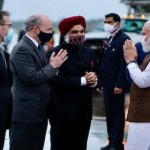Two meetings of the leaders of a plurilateral grouping within seven months is an exceptional development in world affairs, especially when it involves the U.S. and its three Quad partners – Australia, Japan and India. Why the leaders are meeting again on September 24 and what they hope to achieve, are matters of mounting public interest. This first in-person summit is especially significant, set against the backdrop of the Indo-Pacific region grappling with the repercussions of Afghanistan, the growing aggressiveness of China and the formation of AUKUS, a brand-new trilateral security partnership.
The leaders’ summit of the Quadrilateral Framework will be hosted by U.S. President Joseph Biden in Washington. It may be of greater substance than the inaugural virtual summit of March 12, because the context of the two summits is significantly different. In March, the Biden administration had just begun its innings; it was struggling to define its China and Indo-Pacific policies; and expectations from the Quad were low.
A substantive joint statement, reinforced by a smart op-ed by the four leaders in The Washington Post, drew global attention. Now, three weeks after the chaotic and mismanaged withdrawal of U.S. troops from Afghanistan, that country’s future and regional security issues are bound to dominate the discussions. The onus is on the U.S. to convince its partners that the Afghan experience has strengthened, not weakened, its resolve to defend its – and their – interests in the Indo-Pacific.
The AUKUS – the Australia-UK-U.S. partnership – too will need some serious explaining, particularly to Japan and India which worry about the emergence of an inner circle (U.S. and Australia) within the Quad, which is now connected to the U.K., a non-Quad partner. There are even reports that British Pime Minister Boris Johnson may be visiting Washington around the time of the Quad summit.
Indian experts are divided over the impact of AUKUS on the Quad. Some argue that it reduces the Quad’s salience, while others maintain that the Quad is strengthened by the new trilateral. However, a sober evaluation suggests that AUKUS will have both positive and negative implications for the Quad; these will become evident after the forthcoming summit.
Another consequential development is the September 16 release of the European Union’s Indo-Pacific strategy. A shorter version presented in April has now been given a comprehensive form. It paints the EU and the Indo-Pacific as deeply connected in diverse realms ranging from trade and investment to security and defence. The EU’s determination to scale up and diversify cooperation with democratic and like-minded nations could be a boost to the Quad, provided the Europeans are ready to stand up to China’s assertive behaviour, violations of international law and norms, and increasing use of coercion.
These issues will dominate the headlines in Washington for sure. But the Quad also has the necessary and backbreaking work of institutionalising itself to do, and the fulfilling of past commitments. For instance, the joint vaccine production programme seems to be on track and their distribution first to needy Indo-Pacific countries will begin in early 2022. The working group on emerging and critical technologies too is reporting progress. A principal endeavour is to leverage the Open Radio Access Network (O-RAN) to derive benefits of interoperability of the 5G technologies offered by different vendors in the west.
On climate change, the focus of the third working group, some key issues remain unresolved – specifically, India is unable to show ‘more ambitions’ regarding its climate goals, despite two visits to New Delhi this year by John Kerry, the U.S. president’s special envoy on climate. But efforts are underway to finalise technology-sharing and other cooperation to meet the challenges of climate change.
Expansion of the agenda is on the cards, and will include new areas like infrastructure and connectivity, education, cyber security and maritime security. Hopefully it will also include cooperation in the Blue Economy, as all the four nations are endowed with immense oceanic resources.
The special attention to infrastructure comes from the U.S., given its announcement of the ‘Build Back Better World’ (B3W) at the G7 summit last June, but which has yet to become a reality. What the U.S. government will now propose and whether its package will include details such as planning, logistics, new financing and identification of specific projects, will be keenly observed.
With the China challenge now recognized as being both multi-faceted and long-term, the Quad needs to devise a matching strategy. Joint innovative and practical recommendations are worth considering, like The Quad Economy & Technology Task Force Report: A Time for Concerted Action, crafted by international experts and published by think tank Gateway House in August.
India should be cautiously optimistic about the role and prospects of the Quad. Prime Minister Narendra Modi’s visit to Washington will be his first major voyage abroad in the Covid era, after his visit to Dhaka in June this year. His advisers expect India’s strategic perspective will be fully factored in, considering that it is the only Quad power with land borders with China, and a proximity to the serious threat of terrorism, extremism and radicalisation emanating from Afghanistan.
Given India’s pivotal position in the Indo-Pacific region, it may be appropriate if the Quad summit in 2022 is hosted by New Delhi. The nation will be fully ready to assume this responsibility.
This article was first published in The Indian Express.
Rajiv Bhatia is Distinguished Fellow, Foreign Policy Studies Programme, Gateway House and former Ambassador.


